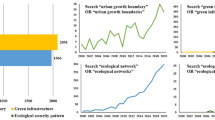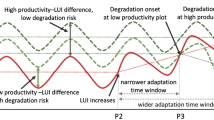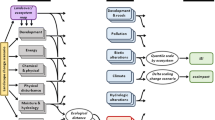Abstract
Context
Existing landscape sustainability studies mostly follow design-based, practical approaches, emphasizing “linking knowledge to action;” while the problem-driven, diagnostic approach that emphasizes “understanding human–environment interactions” remains underused.
Objectives
To apply the problem-driven, diagnostic approach to a widespread and controversial landscape-relevant problem: farmland loss associated with the long-term, global trend of urbanization.
Methods
We comparatively analyzed the farmland loss and landscape dynamics in the core and peripheral areas of rapidly urbanizing Tongling City in China, by using 30 m-grid land use/cover data in 2000, 2005, 2010, and 2015. To understand the temporal trends and abnormalities of farmland loss, we identified probable regime shifts of socioeconomic and agrifood dynamics by changepoint detection using relevant data from 2000 to 2015.
Results
Changes of the whole landscape were dominated by persistent aggressive land gains of developed lands and increasing land losses of farmland and densely/moderately vegetated land. The ratio of farmland loss to total land conversion (8–77%) decreased in general during 2000–2015, with urban encroachment of farmland accounting for 14.72–74.36% of total farmland loss. Farmland had become smaller in patch size, less regular in patch shape, and more isolated between patches since 2005, indicating farmland deintensification. Three temporal abnormalities of farmland change were identified, which were associated with abrupt socioeconomic and agrifood dynamics affecting farmland demand–supply.
Conclusions
Farmland loss is more of an economic issue than a resource issue, and focusing on urban expansion is often inadequate. Policy efforts are needed to address the real problem of social injustice in mandatory farmland preservation practices.







Similar content being viewed by others
References
Alterman R (1997) The challenge of farmland preservation: lessons from a six-nation comparison. J Am Plan Assoc 63:220–243
Anderies JM, Janssen M (2016) Sustaining the commons. Arizona State University, Tempe, AZ
Bren d’Amour C, Reitsma F, Baiocchi G, Barthel S, Güneralp B, Erb K-H, Haberl H, Creutzig F, Seto KC (2017) Future urban land expansion and implications for global croplands. Proc Natl Acad Sci USA 114:8939–8944
Bright EA, Rose AN, Urban ML (2016) LandScan 2015. Oak Ridge National Laboratory, Oak Ridge, TN
Brunstad RJ, Gaasland I, Vårdal E (1995) Agriculture as a provider of public goods: a case study for Norway. Agric Econ 13:39–49
Buyantuyev A, Wu J, Gries C (2010) Multiscale analysis of the urbanization pattern of the Phoenix metropolitan landscape of USA: time, space and thematic resolution. Landsc Urban Plan 94:206–217
Chenery HB, Syrquin M, Elkington H (1975) Patterns of development, 1950–1970. Oxford University Press London, New York
Chien S-S (2015) Local farmland loss and preservation in China—A perspective of quota territorialization. Land Use Policy 49:65–74
Costanza R, d'Arge R, de Groot R, Farber S, Grasso M, Hannon B, Naeem S, Limburg K, Paruelo J, O'Neill RV (1997) The value of the world's ecosystem services and natural capital. Nature 387:253–260
Cumming GS, Epstein G (2020) Landscape sustainability and the landscape ecology of institutions. Landsc Ecol. https://doi.org/10.1007/s10980-020-00989-8
DeFries RS, Foley JA, Asner GP (2004) Land-use choices: balancing human needs and ecosystem function. Front Ecol Environ 2:249–257
Deng X, Huang J, Rozelle S, Zhang J, Li Z (2015) Impact of urbanization on cultivated land changes in China. Land Use Policy 45:1–7
Edgens JG, Staley SR, (1999) The myth of farmland loss. In Forum for applied research and public policy. Executive Sciences Institute, pp. 29–34
Fang X, Zhou B-B, Tu X, Ma Q, Wu J (2018) What kind of a science is sustainability science? an evidence-based reexamination. Sustainability 10:1478
Fernández IC, Wu J (2018) A GIS-based framework to identify priority areas for urban environmental inequity mitigation and its application in Santiago de Chile. Appl Geogr 94:213–222
Fischel WA (1982) The urbanization of agricultural land: a review of the National Agricultural Lands Study. Land Econ 58:236–259
Fuchs R, Herold M, Verburg PH, Clevers JGPW, Eberle J (2015) Gross changes in reconstructions of historic land cover/use for Europe between 1900 and 2010. Glob Change Biol 21:299–313
Gottlieb PD (2015) Is America running out of farmland? Choices 30:1–6
He C, Liu Z, Xu M, Ma Q, Dou Y (2017) Urban expansion brought stress to food security in China: evidence from decreased cropland net primary productivity. Sci Total Environ 576:660–670
Heerink N, Kuiper M, Shi X (2006) China's new rural income support policy: impacts on grain production and rural income inequality. China World Econ 14:58–69
Hesselbarth MHK, Sciaini M, With KA, Wiegand K, Nowosad J (2019) landscapemetrics: an open-source R tool to calculate landscape metrics. Ecography 42:1648–1657
Huang C, Wang Y, Li X, Ren L, Zhao J, Hu Y, Zhang L, Fan G, Xu J, Gu X, Cheng Z, Yu T, Xia J, Wei Y, Wu W, Xie X, Yin W, Li H, Liu M, Xiao Y, Gao H, Guo L, Xie J, Wang G, Jiang R, Gao Z, Jin Q, Wang J, Cao B (2020) Clinical features of patients infected with 2019 novel coronavirus in Wuhan, China. The Lancet 395:497–506
Jiang L, Deng X, Seto KC (2013) The impact of urban expansion on agricultural land use intensity in China. Land Use Policy 35:33–39
Kates RW, Parris TM, Leiserowitz AA (2005) What is sustainable development? Goals, indicators, values, and practice. Environment 47:8–21
Levin S (2015) Foreword. In: Barrett GW, Barrett TL, Wu J (eds) History of landscape ecology in the United States. Springer, New York, pp 13–30
Li L, Fassnacht FE, Storch I, Bürgi M (2017) Land-use regime shift triggered the recent degradation of alpine pastures in Nyanpo Yutse of the eastern Qinghai-Tibetan Plateau. Landsc Ecol 32:1–17
Lin M, Huang Q (2019) Exploring the relationship between agricultural intensification and changes in cropland areas in the US. Agr Ecosyst Environ 274:33–40
Liu J, Kuang W, Zhang Z, Xu X, Qin Y, Ning J, Zhou W, Zhang S, Li R, Yan C (1980s) Spatiotemporal characteristics, patterns, and causes of land-use changes in China since the late 1980s. J Geog Sci 24:195–210
Liu J, Liu M, Deng X, Zhuang D, Zhang Z, Luo D (2002) The land use and land cover change database and its relative studies in China. J Geog Sci 12:275–282
Liu J, Liu M, Tian H, Zhuang D, Zhang Z, Zhang W, Tang X, Deng X (2005) Spatial and temporal patterns of China's cropland during 1990–2000: an analysis based on Landsat TM data. Remote Sens Environ 98:442–456
Liu L, Xu X, Chen X (2015) Assessing the impact of urban expansion on potential crop yield in China during 1990–2010. Food Secur 7:33–43
Liu Z, He C, Yang Y, Fang Z (2020) Planning sustainable urban landscape under the stress of climate change in the drylands of northern China: a scenario analysis based on LUSD-urban model. J Clean Prod 244:118709
Mao D, Wang Z, Wu J, Wu B, Zeng Y, Song K, Yi K, Luo L (2018) China's wetlands loss to urban expansion. Land Degrad Dev 29:2644–2657
McGarigal K, Cushman SA, Ene E. (2012). FRAGSTATS v4: Spatial Pattern Analysis Program for Categorical and Continuous Maps. v4, University of Massachusetts, Amherst, MA.
Mulligan GF (2013) Revisiting the urbanization curve. Cities 32:113–122
Musacchio LR (2009) The scientific basis for the design of landscape sustainability: a conceptual framework for translational landscape research and practice of designed landscapes and the six Es of landscape sustainability. Landsc Ecol 24:993–1013
Musacchio LR (2011) The grand challenge to operationalize landscape sustainability and the design-in-science paradigm. Landsc Ecol 26:1–5
Mustard JF, DeFries RS, Fisher T, Moran E (2004) Land-ue and land-cover change pathways and impacts. In: Gutman G, Janetos AC, Justice CO, Moran EF, Mustard JF, Rindfuss RR, Skole D, Turner BL II, Cochrane MA (eds) Land change science: observing, monitoring and understanding trajectories of change on the earth’s surface. Springer Science & Business Media, Dordrecht The Netherlands
Nassauer JI, Opdam P (2008) Design in science: extending the landscape ecology paradigm. Landsc Ecol 23:633–644
Naughton B (2009) Understanding the Chinese stimulus package. China Leadersh Monit 28:1–12
Opdam P (2018) Exploring the role of science in sustainable landscape management. An introduction to the special issue. Sustainability 10:331
Opdam P (2020) Navigating the space between landscape science and collective action for sustainability: identifying key factors in information processing. Landsc Ecol. https://doi.org/10.1007/s10980-020-01028-2
Opdam P, Luque S, Nassauer J, Verburg PH, Wu J (2018) How can landscape ecology contribute to sustainability science? Landsc Ecol 33:1–7
Opdam P, Steingröver E, Van Rooij S (2006) Ecological networks: a spatial concept for multi-actor planning of sustainable landscapes. Landsc Urban Plann 75:322–332
Ostrom E (1990) Governing the commons: the evolution of institutions for collective action. Cambridge University Press, New York
Ostrom E (2007) A diagnostic approach for going beyond panaceas. Proc Natl Acad Sci USA 104:15181–15187
Pandey B, Seto KC (2015) Urbanization and agricultural land loss in India: comparing satellite estimates with census data. J Environ Manage 148:53–66
Pohlert, T. (2015). Trend: non-parametric trend tests and change-point detection, R package version 0.0.1.
Riitters K (2019) Pattern metrics for a transdisciplinary landscape ecology. Landsc Ecol. https://doi.org/10.1007/s10980-018-0755-4
Rudel TK, Schneider L, Uriarte M, Turner BL, DeFries R, Lawrence D, Geoghegan J, Hecht S, Ickowitz A, Lambin EF, Birkenholtz T, Baptista S, Grau R (2009) Agricultural intensification and changes in cultivated areas, 1970–2005. Proc Natl Acad Sci USA 106:20675–20680
Seto KC, Kaufmann RK, Woodcock CE (2000) Landsat reveals China's farmland reserves, but they're vanishing fast. Nature 406:121
Shen X, Wang L, Wu C, Lv T, Lu Z, Luo W, Li G (2017) Local interests or centralized targets? How China’s local government implements the farmland policy of Requisition-Compensation Balance. Land Use Policy 67:716–724
Sleeter BM, Sohl TL, Loveland TR, Auch RF, Acevedo W, Drummond MA, Sayler KL, Stehman SV (2013) Land-cover change in the conterminous United States from 1973 to 2000. Global Environ Change 23:733–748
Tongling Statistical Bureau. 2016. Tongling Statistical Yearbook 2016. 518. Tonling.
Turner MG (2010) A landscape perspective on sustainability science. In: Levin S, Clark WC (eds) Toward a science of sustainability. Princeton University, Princeton, NJ, pp 79–82
United Nations. (1974). Methods for projections of urban and rural population. New York.
van Vliet J, Eitelberg DA, Verburg PH (2017) A global analysis of land take in cropland areas and production displacement from urbanization. Global Environ Change 43:107–115
Wang J, Wu Q, Yan S, Guo G, Peng S (2020) China’s local governments breaking the land use planning quota: a strategic interaction perspective. Land Use Policy 92:104434
Wang X, Shen Y (2014) The effect of China's agricultural tax abolition on rural families' incomes and production. China Econ Rev 29:185–199
Wang Y, van Vliet J, Pu L, Verburg PH (2019) Modeling different urban change trajectories and their trade-offs with food production in Jiangsu Province, China. Comput Environ Urban Syst 77:101355
WBGU - German Advisory Council on Global Change (1997) World in transition: the research challenge. Springer, Berlin
Wu J (2006) Landscape ecology, cross-disciplinarity, and sustainability science. Landsc Ecol 21:1–4
Wu J (2012) A landscape approach for sustainability science. In: Weinstein MP, Turner RE (eds) Sustainability science: the emerging paradigm and the urban environment. Springer, New York, pp 59–77
Wu J (2013) Landscape sustainability science: ecosystem services and human well-being in changing landscapes. Landsc Ecol 28:999–1023
Wu J (2019) Linking landscape, land system and design approaches to achieve sustainability. J Land Use Sci. https://doi.org/10.1080/1747423X.2019.1602677
Wu Y, Xi X, Tang X, Luo D, Gu B, Lam SK, Vitousek PM, Chen D (2018) Policy distortions, farm size, and the overuse of agricultural chemicals in China. Proc Natl Acad Sci USA 115:7010–7015
Yu Q, Hu Q, van Vliet J, Verburg PH, Wu W (2018) GlobeLand30 shows little cropland area loss but greater fragmentation in China. Int J Appl Earth Obs Geoinf 66:37–45
Zhang W, Wang W, Li X, Ye F (2014) Economic development and farmland protection: an assessment of rewarded land conversion quotas trading in Zhejiang, China. Land Use Policy 38:467–476
Zhou B-B (2020) Scientific foundations and problem-driven case studies of landscape sustainability: sustainability of human-environment systems through the lens of the landscape. Ph.D. Dissertation. School of sustainability, Arizona state university, Tempe, Arizona, USA
Zhou B-B, Wu J, Anderies JM (2019) Sustainable landscapes and landscape sustainability: a tale of two concepts. Landsc Urban Plann 189:274–284
Zhou Y, Smith SJ, Zhao K, Imhoff M, Thomson A, Bond-Lamberty B, Asrar GR, Zhang X, He C, Elvidge CD (2015) A global map of urban extent from nightlights. Environ Res Lett 10:054011
Acknowledgements
This work was supported by National Natural Science Foundation of China [41801169] and Natural Science Foundation of Jiangsu Province, China [BK20180819].
Author information
Authors and Affiliations
Contributions
BBZ: Conceptualization, Methodology, Data acquisition, Formal analysis, Writing—Original Draft, Writing—Review & Editing. LL: Funding acquisition, Data acquisition, Writing—Review & Editing.
Corresponding author
Ethics declarations
Conflict of interest
The authors declare that they have no conflict of interest.
Additional information
Publisher's Note
Springer Nature remains neutral with regard to jurisdictional claims in published maps and institutional affiliations.
Electronic supplementary material
Below is the link to the electronic supplementary material.
Rights and permissions
About this article
Cite this article
Zhou, BB., Lv, L. Understanding the dynamics of farmland loss in a rapidly urbanizing region: a problem-driven, diagnostic approach to landscape sustainability. Landscape Ecol 35, 2471–2486 (2020). https://doi.org/10.1007/s10980-020-01074-w
Received:
Accepted:
Published:
Issue Date:
DOI: https://doi.org/10.1007/s10980-020-01074-w




